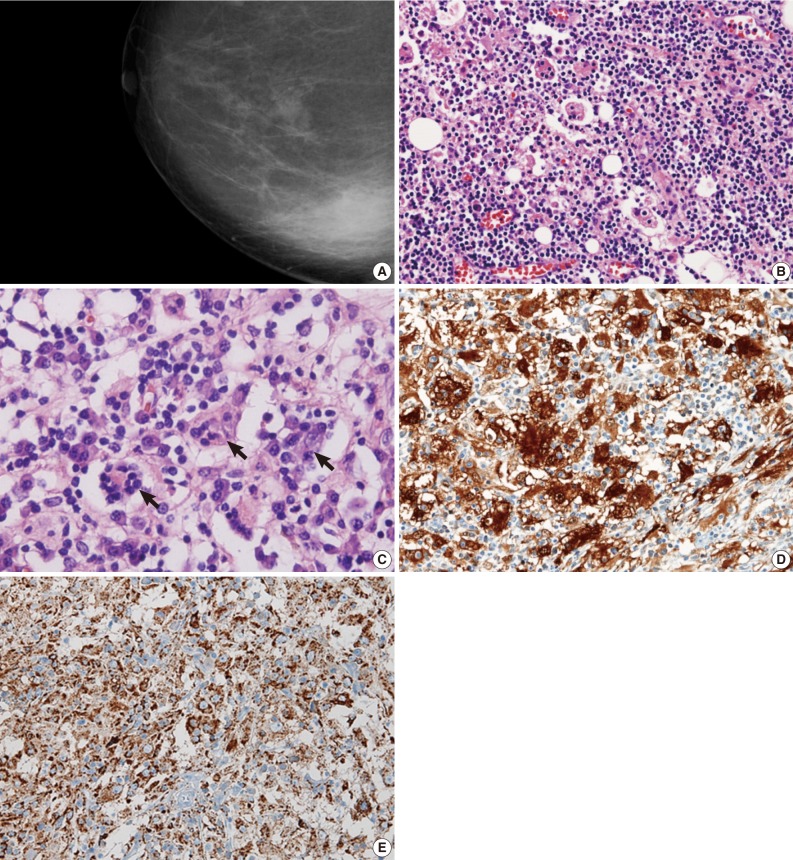Articles
- Page Path
- HOME > J Pathol Transl Med > Volume 46(5); 2012 > Article
-
Case Report
Rosai-Dorfman Disease in the Breast with Increased IgG4 Expressing Plasma Cells: A Case Report - Yoon Jin Cha, Woo Ick Yang, Se Ho Park1, Ja Seung Koo
-
Korean Journal of Pathology 2012;46(5):489-493.
DOI: https://doi.org/10.4132/KoreanJPathol.2012.46.5.489
Published online: October 25, 2012
Department of Pathology, Yonsei University College of Medicine, Seoul, Korea.
1Department of General Surgery, Yonsei University College of Medicine, Seoul, Korea.
- Corresponding Author: Ja Seung Koo, M.D. Department of Pathology, Yonsei University College of Medicine, 50 Yonsei-ro, Seodaemun-gu, Seoul 120-752, Korea. Tel: +82-2-2228-1772, Fax: +82-2-362-0860, KJS1976@yuhs.ac
• Received: October 25, 2011 • Revised: December 13, 2011 • Accepted: December 15, 2011
© 2012 The Korean Society of Pathologists/The Korean Society for Cytopathology
This is an Open Access article distributed under the terms of the Creative Commons Attribution Non-Commercial License (http://creativecommons.org/licenses/by-nc/3.0) which permits unrestricted non-commercial use, distribution, and reproduction in any medium, provided the original work is properly cited.
Figure & Data
References
Citations
Citations to this article as recorded by 

- Diagnosis and management of Rosai–Dorfman disease of the breast: Case report and literature review
Jessman King Lun Lo, Sara Wai Wun Fung, Zara Chui San Tsang
Surgical Practice.2024; 28(4): 229. CrossRef - IgG4-related Breast Disease: Review of the Literature
Helana Jeries, Yolanda Braun-Moscovici, Alexandra Balbir-Gurman
Rambam Maimonides Medical Journal.2024; 15(4): e0018. CrossRef - Pathology of IgG4-related sclerosing mastitis
Polycarp Erivwo, Gulisa Turashvili
Journal of Clinical Pathology.2021; 74(8): 475. CrossRef - Rosai–Dorfman Disease: Breast Involvement—Case Report and Literature Review
George Iancu, Nicolae Gica, Laura Mihaela Mustata, Anca Maria Panaitescu, Danut Vasile, Gheorghe Peltecu
Medicina.2021; 57(11): 1167. CrossRef - Sonographic features of Rosai‐Dorfman disease in the breast: A case report
Gi W. Shin, Young M. Park, Young J. Heo, Jin W. Baek, Yoo J. Lee, Ji Y. Han, Hayoung Park
Journal of Clinical Ultrasound.2020; 48(2): 108. CrossRef - Rosai-Dorfman Disease of the Breast With Variable IgG4+ Plasma Cells
Jenny C. Hoffmann, Chieh-Yu Lin, Siddhartha Bhattacharyya, Olga K. Weinberg, Karen M. Chisholm, Michael Bayerl, Michael Cascio, Girish Venkataraman, Kimberly Allison, Megan Troxell, Chung-Che Chang, Adam Bagg, Tracy I. George, Dennis O’Malley, Robert S. O
American Journal of Surgical Pathology.2019; 43(12): 1653. CrossRef - Rosai-Dorfman disease presenting as a breast mass
Dai Ding*, Cai Qi, Vohra Nasreen A. , Wong Jan, Therien Zsuzsanna P. , Hewan-Lowe Karlene , Sutton Ann
Archives of Pathology and Clinical Research.2019; 3(1): 008. CrossRef - Erdheim-Chester Disease Involving Lymph Nodes and Liver Clinically Mimicking Lymphoma: A Case Report
Yeoun Eun Sung, Yoon Seo Lee, Jieun Lee, Kyo Young Lee
Journal of Pathology and Translational Medicine.2018; 52(3): 183. CrossRef - Enfermedad de Rosai-Dorfman en mama de paciente masculino: una entidad rara
Paola Iturralde Rosas-Priego, José Daniel Flores-Alatriste, Daniela Stuht López, Javier Gómez Pedroso-Rea, Cecilia Ortiz-de-Iturbide, Jorge Valenzuela-Tamariz, Manuel Ubiergo-García
Revista de Senología y Patología Mamaria.2018; 31(2): 72. CrossRef - Increased Immunoglobulin G4-positive Plasma Cells in Lymphadenoma of the Salivary Gland: An Immunohistochemical Comparison Among Lymphoepithelial Lesions
Jiyoon Kim, Joon Seon Song, Jong-Lyel Roh, Seung-Ho Choi, Soon Yuhl Nam, Sang Yoon Kim, Kyung-Ja Cho
Applied Immunohistochemistry & Molecular Morphology.2018; 26(6): 420. CrossRef - IgG4-Related Sclerosing Disease of the Breast in a Male Patient
Taisia Vitkovski, Galina S. Marder, Dominic A. Filardi, Ekta Gupta, Frank Breuer
International Journal of Surgical Pathology.2017; 25(8): 711. CrossRef - Extranodal manifestation of Rosai-Dorfman disease in the breast tissue
Qiao Zhou, Umer Ansari, Nandan Keshav, Fiona Davis, Maria Cundiff
Radiology Case Reports.2016; 11(3): 125. CrossRef - Rosai-Dorfman Disease with Massive Cutaneous Nodule on the Shoulder and Back
Han Ma, Yue Zheng, Guoxing Zhu, Jie Wu, Chun Lu, Wei Lai
Annals of Dermatology.2015; 27(1): 71. CrossRef - IgG4-related disease of the breast: a systemic disease whose mammary manifestations mimic breast cancer
Takuya Moriya, Hisashi Hirakawa, Maki Nagashima, Mitsuhiko Yasuda, Izo Kimijima
International Cancer Conference Journal.2015; 4(2): 67. CrossRef - Primary Cutaneous Marginal IgG4 Lymphoma and Rosai–Dorfman's Disease Coexisting in Several Lesions of the Same Patient
Salma Machan, Camino Medina, Socorro María Rodríguez-Pinilla, José M. Suárez-Peñaranda, Yolanda Castro, Paula Molés, Celia Requena, Carles Saus, Luis Requena, Carlos Santonja
The American Journal of Dermatopathology.2015; 37(5): 413. CrossRef - A subset of Rosai–Dorfman disease cases show increased IgG4‐positive plasma cells: another red herring or a true association with IgG4‐related disease?
Madhu P Menon, Moses O Evbuomwan, Juan Rosai, Elaine S Jaffe, Stefania Pittaluga
Histopathology.2014; 64(3): 455. CrossRef - Freiburg Neuropathology Case Conference: A Partially Calcified, Dura-based Tumour of the Frontal Lobe
C. A. Taschner, O. Staszewski, R. Jabbarli, A. Keuler, M. Prinz
Clinical Neuroradiology.2013; 23(1): 63. CrossRef - Pulmonary IgG4+ Rosai-Dorfman disease
Karim El-Kersh, Rafael L Perez, Juan Guardiola
BMJ Case Reports.2013; 2013: bcr2012008324. CrossRef
Rosai-Dorfman Disease in the Breast with Increased IgG4 Expressing Plasma Cells: A Case Report


Fig. 1 Mammography revealing an ill-defined mass in the right lower breast (A). Numerous histiocytes showing pink, abundant cytoplasm (B) containing intact inflammatory cells (emperipolesis, arrows) (C). Nuclear and cytoplasmic S-100 protein expression of histiocytes highlighting the entrapped inflammatory cells in their cytoplasm, which are negative for S-100 protein (D). Histiocytes expressing CD68 in cytoplasm (E).
Fig. 2 Normal breast lobules are not identifiable due to sclerotic, fibrous stroma (A). Many IgG-expressing plasma cells (B) also showing reactivity for IgG4 (C).
Fig. 1
Fig. 2
Rosai-Dorfman Disease in the Breast with Increased IgG4 Expressing Plasma Cells: A Case Report

Table 1 Differential diagnosis of non-epithelial mass forming lesion in breast with hitiocytes
RDD, Rosai-Dorfman disease; LCH, Langerhans' cell histiocytosis.

 E-submission
E-submission



 PubReader
PubReader Cite this Article
Cite this Article



